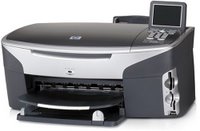I have a home Wi-Fi net and broadband connection, but I would also like to be able to use my printer wirelessly. Should I get a Bluetooth printer or a Wi-Fi adapter?
While Bluetooth can be found in some new printers allowing direct printing from your Bluetooth laptop, using a Wi-Fi print server makes much better sense. With Bluetooth, you'll need to be within a few feet of your printer, and you won't be able to network the printer for use with other computers in your home. With Wi-Fi, you can print from anywhere within range of your router, and from any computer.
You can either buy a Wi-Fi router with a built-in USB or parallel print server (depending on your printer's interface), or a separate print server that communicates wirelessly with your router. We prefer the separate approach, since it doesn't restrict your router choices, and you can replace or upgrade components as new technology emerges.
Two good Wi-Fi print server options for Windows users are the Belkin 802.11g Wireless Print Server, which has dual USB 1.1 ports for connecting two printers to your network, and the Linksys Wireless-G PrintServer, which has one USB 2.0 port and one parallel port.
Mac users should consider Apple's AirPort Extreme and AirPort Express routers, which have built-in USB print servers that support both Mac and PC clients, as well as AppleTalk printers.
 One catch with print servers is that they generally don't support the fax/copy/scan functions of all-in-one printers. They only support printing. So you won't be able to send or receive faxes or scans between your computer and the printer. You can still use the standalone fax and copy features of the printer, of course. If you really need a wireless multifunction solution, consider HP's Photosmart 2710 All-in-One ($399), which has both 802.11g and Bluetooth support. It also has color print, flatbed fax, scan, and copy functions, and it works with both Macs and PCs.
One catch with print servers is that they generally don't support the fax/copy/scan functions of all-in-one printers. They only support printing. So you won't be able to send or receive faxes or scans between your computer and the printer. You can still use the standalone fax and copy features of the printer, of course. If you really need a wireless multifunction solution, consider HP's Photosmart 2710 All-in-One ($399), which has both 802.11g and Bluetooth support. It also has color print, flatbed fax, scan, and copy functions, and it works with both Macs and PCs.
While Bluetooth can be found in some new printers allowing direct printing from your Bluetooth laptop, using a Wi-Fi print server makes much better sense. With Bluetooth, you'll need to be within a few feet of your printer, and you won't be able to network the printer for use with other computers in your home. With Wi-Fi, you can print from anywhere within range of your router, and from any computer.
You can either buy a Wi-Fi router with a built-in USB or parallel print server (depending on your printer's interface), or a separate print server that communicates wirelessly with your router. We prefer the separate approach, since it doesn't restrict your router choices, and you can replace or upgrade components as new technology emerges.
Two good Wi-Fi print server options for Windows users are the Belkin 802.11g Wireless Print Server, which has dual USB 1.1 ports for connecting two printers to your network, and the Linksys Wireless-G PrintServer, which has one USB 2.0 port and one parallel port.
Mac users should consider Apple's AirPort Extreme and AirPort Express routers, which have built-in USB print servers that support both Mac and PC clients, as well as AppleTalk printers.
 One catch with print servers is that they generally don't support the fax/copy/scan functions of all-in-one printers. They only support printing. So you won't be able to send or receive faxes or scans between your computer and the printer. You can still use the standalone fax and copy features of the printer, of course. If you really need a wireless multifunction solution, consider HP's Photosmart 2710 All-in-One ($399), which has both 802.11g and Bluetooth support. It also has color print, flatbed fax, scan, and copy functions, and it works with both Macs and PCs.
One catch with print servers is that they generally don't support the fax/copy/scan functions of all-in-one printers. They only support printing. So you won't be able to send or receive faxes or scans between your computer and the printer. You can still use the standalone fax and copy features of the printer, of course. If you really need a wireless multifunction solution, consider HP's Photosmart 2710 All-in-One ($399), which has both 802.11g and Bluetooth support. It also has color print, flatbed fax, scan, and copy functions, and it works with both Macs and PCs.

0 comments: